 Squier’s 60th Anniversary Classic Vibe ‘50s Stratocaster has a maple neck with a “modern C” profile, 9.5”-radius maple fingerboard with 21 medium jumbo frets, three vintage-style single-coil pickups with five-way switching, three-ply parchment pickguard, vintage-style synchronized vibrato bridge with six saddles, vintage-style tuners, and an Aztec Gold finish with gold hardware. For more, go to www.squierguitars.com.
Squier’s 60th Anniversary Classic Vibe ‘50s Stratocaster has a maple neck with a “modern C” profile, 9.5”-radius maple fingerboard with 21 medium jumbo frets, three vintage-style single-coil pickups with five-way switching, three-ply parchment pickguard, vintage-style synchronized vibrato bridge with six saddles, vintage-style tuners, and an Aztec Gold finish with gold hardware. For more, go to www.squierguitars.com.
Year: 2014
-
Squier offers 60th Anniversary Classic Vibe ‘50s Strat
-
Gator Cases Adds LP, 335 Journeyman Models
 Gator Cases has expanded its Journeyman series to include cases custom fit for Gibson Les Paul and 335 guitars. Constructed of plywood, each has a pebble-weaved burlap wrapping with espresso brown trim, antiqued brass hardware, royal blue crushed-velvet interior, and an accessory storage compartment. Visit www.gatorcases.com.
Gator Cases has expanded its Journeyman series to include cases custom fit for Gibson Les Paul and 335 guitars. Constructed of plywood, each has a pebble-weaved burlap wrapping with espresso brown trim, antiqued brass hardware, royal blue crushed-velvet interior, and an accessory storage compartment. Visit www.gatorcases.com. -
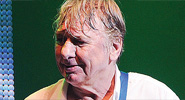
Mick Ralphs

Photo: Larry Morano.
Guitarist Mick Ralphs, whose pulverizing riffs were first heard in the late ’60s in the original Mott the Hoople, has charged back into the limelight.Mott was a ferocious quintet, and one of the most highly-underrated bands of that era. Ralphs’ six-album experience in the band was followed by his tenure in Bad Company, a supergroup that formed in ’73, and was signed to Led Zeppelin’s Swan Song label. The membership also included vocalist Paul Rodgers and drummer Simon Kirke (both ex-Free) and bassist Boz Burrell, formerly of King Crimson.
Bad Company scored numerous mega-hits, but also went through various personnel changes over the years. The original foursome regrouped in 1999 for a limited tour, after which Ralphs and Burrell opted to get off the road.
“After the ’99 tour, I recorded a bunch of songs at home, playing all the instruments which were subsequently released on two albums, It’s All Good and That’s Life – Can’t Get Enough, on Angel Air Records,” Ralphs recently told VG. “After that, I toured with (former Mott vocalist) Ian Hunter, which was great! I have a lot of love and respect for the man – he’s such a great writer, and a wonderful person.”
A heart attack claimed Boz Burrell in 2006, and the remaining members of the original Bad Company regrouped for a 2008 concert in Florida. A DVD documented that effort, and while they noted the memory of their former bassist, his death wasn’t the primary reason for the reunion.
“It was a means to re-establish the name Bad Company with the remaining three members, to avoid any other versions of the band trading as Bad Company,” the guitarist explained. “Obviously, Boz was dearly missed by all of us… and I still miss him terribly.”
Supplementing the original threesome were guitarist Howard Leese (formerly with Heart) and bassist Lynn Sorensen, both of whom have played with Rodgers for a number of years. The reunion gig went so well the members decided to tour. However, Ralphs had another reunion to coordinate, as the original fivesome of Mott the Hoople was slated for a series of performances in England in late 2009, so he quickly worked into that project, as well.
As it turned out, the Pretenders’ Martin Chambers played drums at the Mott the Hoople shows, due to original drummer Dale “Buffin” Griffin’s health problems. Griffin sat in for the encores.
“It was well-timed,” Ralphs said of the Mott reunion. “I had just finished a U.S. Bad Company tour and went straight into the Mott rehearsals!”
A 2010 Bad Company tour of England offered an opportunity for a first-ever live recording by the remaining original members (with Leese and Sorensen still onboard), and the documentation took place on the tour’s final stop, at Wembley Stadium.
“It seemed appropriate to record the band live in the U.K., since we never put out a live album in the day,” said Ralphs.
The result was Bad Company Live at Wembley (Eagle Rock), a tour-de-force document of a veteran band in fine form. The CD proffers 15 of the band’s classics, and the DVD includes “Burnin’ Sky” and a bonus feature of interviews with band members.

Some things don’t change over the decades…“I still love my Gibson Les Paul and my old Fender Esquire, so why change?” he said. “I have been using a ’58 (reissue) chambered Les Paul for about four years now, and it’s the best-sounding Les Paul I have ever played, including some of the vintage ’58 and ’59 guitars! The ’57 Esquire is used on the songs with open-C tuning, like ‘Movin’ On,’ ‘Can’t Get Enough,’ ‘Honey Child,’ etc.”
“Seagull” is an acoustic presentation featuring just Rodgers and Ralphs, who plays his Yamaha LLX16, which he describes as “a very nice guitar.”
Ralphs is upbeat about the way Bad Company Live at Wembley turned out, but further tours by that aggregation aren’t in the offing. He does, however, plan on continuing to perform.
“There are no plans for BadCo at present,” Ralphs said. “But I’ve put together a blues band – called the Mick Ralphs Blues Band, amazingly (laughs) – and it’s great, playing the blues with a great bunch of guys. There’s Dicky Baldwin on bass, Sam Kelly on drums, Jim Maving on guitar, and Stuart Maxwell on harmonica and vocals. We’ll be doing gigs in the U.K. in the fall.”
This article originally appeared in VG December 2011 issue. All copyrights are by the author and Vintage Guitar magazine. Unauthorized replication or use is strictly prohibited.
-
Perri Ink Debuts Gypsy Model
 Perri Ink Custom Guitars’ Gypsy model guitar is the company’s first original design. It has a swamp ash body with ash pickguard, quartersawn maple neck, rosewood fingerboard, clay inlays, and a reverse headstock. Other features include three Seymour Duncan Antiquity Texas Hot pickups and a Callaham vintage-style vibrato. Each is custom-built to order, and made U.S. For more, visit http://perriinkguitars.com.
Perri Ink Custom Guitars’ Gypsy model guitar is the company’s first original design. It has a swamp ash body with ash pickguard, quartersawn maple neck, rosewood fingerboard, clay inlays, and a reverse headstock. Other features include three Seymour Duncan Antiquity Texas Hot pickups and a Callaham vintage-style vibrato. Each is custom-built to order, and made U.S. For more, visit http://perriinkguitars.com. -

Dinosaur Jr.
 Though he introduced unabashed (and deafening) guitar heroics to the indie slacker nation, Dinosaur Jr.’s J Mascis is more often cast as an impossible misanthrope. This stunning new coffee-table book, though brimming with ultra-rare photography and memorabilia, also details all the sonic and personal mayhem in the words of the founding members, colleagues, and associates. Notably, bassist Lou Barlow and drummer Murph record frank accounts of their bitter fallings out with Mascis, as well as the trio’s reconciliation, while Mascis offers contrite hindsight.
Though he introduced unabashed (and deafening) guitar heroics to the indie slacker nation, Dinosaur Jr.’s J Mascis is more often cast as an impossible misanthrope. This stunning new coffee-table book, though brimming with ultra-rare photography and memorabilia, also details all the sonic and personal mayhem in the words of the founding members, colleagues, and associates. Notably, bassist Lou Barlow and drummer Murph record frank accounts of their bitter fallings out with Mascis, as well as the trio’s reconciliation, while Mascis offers contrite hindsight.Also entertaining are accounts of Mascis’ first Jazzmaster purchase (from “Slimy Bob’s Guitar Ripoff”), his pedals and amps, and contemporary guitarists’ reactions to him and the band. “What J was the first to do was turn his amp full up and position it right behind his vocal mic,” says Bob Mould, a man who knows a thing or two about volume. “Then every time he moved his head just half an inch to either side, you’d think you were hearing guitars for the rest of your life.”
Available in limited quantities, including a “signature edition” with facsimile tour diaries, this is a fantastic chronicle of an influential band and an often overlooked guitarist.
This article originally appeared in VG‘s January. ’13 issue. All copyrights are by the author and Vintage Guitar magazine. Unauthorized replication or use is strictly prohibited.
-
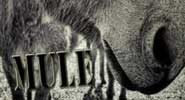
Port City Prophets
 The Prophets are a blues-rock bar band that brings around a lot of people to music they might not otherwise have heard. The PCPs will remind you of both Grand Funk and ZZ Top. With the opening cut “Close Your Eyes,” they’ll also bring fond echoes of Lee Michaels to those who remember.
The Prophets are a blues-rock bar band that brings around a lot of people to music they might not otherwise have heard. The PCPs will remind you of both Grand Funk and ZZ Top. With the opening cut “Close Your Eyes,” they’ll also bring fond echoes of Lee Michaels to those who remember.When guitarist Troy Tolle breaks out the slide for the slow, funky blues of “Jesus Saved My Soul, But…” the ZZ Top connection shows through musically and thematically. But the power, straightforwardness, and bassist Tim Kirkendall’s Mark-Farner-like vocals remind one most of Grand Funk. Tolle’s showcase guitar is more fluid and a bit more dazzling than Farner’s, but the sweat energy, helped in no small part by Henry Ancrum’s drums, is up there with the best of them.
The Port City Prophets are capable of making the transition from bar-walking, crowd-pumping, guitar-centric bar band to one that can come up with the goods to make a solid record – which is exactly what they have done with Mule.
This article originally appeared in VG‘s February ’13 issue. All copyrights are by the author and Vintage Guitar magazine. Unauthorized replication or use is strictly prohibited.
-
LMI Postpones Healdsburg Guitar Festival
Luthiers Mercantile International, organizers of the renowned Healdsburg Guitar Festival, today announced it has postponed the next such festival until 2016.
“In August, 2013, we enjoyed our most successful festival ever,” said LMI sales manager Chris Herrod said in a written statement. “Financially, personally, and logistically, we couldn’t have been more pleased. But after having taken a closer look at our investment, especially in the amount of hours which could have been focused on expanding LMI’s core business, it became obvious that our ‘labor of love’ had many intangible costs, especially to our overworked staff. For this reason, we have made the tough decision to postpone the next festival to 2016.
“No doubt this will come as difficult news to many of you. It has not been an easy decision to make and we understand the ramifications. Besides being a great reunion of friends and colleagues, the festival has been successful in its mission of strengthening the marketplace for handmade instruments. We remain committed to this goal and are confident that after this longer than normal recess that the festival will return stronger than before.”
LMI has presented the Healdsburg festival 10 times since 1996. For more, visit lmii.com.
-
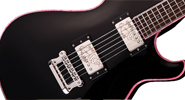
Knaggs Guitars’ Steve Stevens Signature Model
Knaggs Guitars’ Steve Stevens Signature Model
Price: $6,000
Contact: www.knaggsguitars.comEveryone wants to build a better mousetrap, and those who build solidbody guitars are no different. Frequently, they strive to make superior versions of classic archetypes like the Stratocaster, Telecaster, Les Paul, Explorer, Flying V, etc. The Knaggs Steve Stevens Signature Model is derived from the venerable Les Paul, but with many upgrades. But is the Steve Stevens a better LP?
Luthier Joe Knaggs shot to prominence over the past three years with a line of impeccably built electrics and acoustics. The SS is no exception. With fine appointments and an impressive “thump factor” before it’s even plugged in or a chord is strummed, the Steve Stevens just feels like a serious build.
The guitar has a classic mahogany body with a carved maple top finished in a rich, opaque black called Faded Onyx, with pink binding per Stevens’ request. The set mahogany neck has Knaggs’ SS neck carve, which has an appealling, meaty profile comparable to a great ’50s Gibson neck – substantial but not oppressively fat. A 243/4″ scale with a 111/16″ nut width and 12″ radius, and a 22-fret rosewood fingerboard offer further evidence of LP inspiration. However, the design of the SS allows for a degree of upper-fret access that LP players can only dream about, the result of Knaggs’ less-blocky neck heel. On the Steve Stevens, a player can grab and bend that high D on the 22nd fret to E with relative ease – try that with a Les Paul. For decoration, the fingerboard has pink binding and Knaggs’ custom “morning star” inlays.
In terms of hardware, the big news is the Knaggs Influence Series “two-in-one” tailpiece, which sports a TonePros nickel bridge. Combining a tune-o-matic design and string holder in one unit for increased harmonics and sustain, this is one of the more-intriguing developments in bridge design in years. The SS has three-on-a-side nickel Grover tuners and black tophat knobs for the Volume and Tone controls. The nut is hand-cut bone and the pickups are Bare Knuckle humbuckers with Stevens’ trademark raygun graphic laser-etched on them. The image is also inlaid on the headstock, with Stevens’ signature cut into the truss-rod cover.
In performance, the Steve Stevens is a “wow” experience. It’s hefty, but not heavy, and hangs comfortably on a strap. When running the gamut from clean to dirty, it’s amazing how cleanly the tone cuts through any din – the Bare Knuckle pickups sound big and clean, with a medium output that lets the body resonance come through. Still, this guitar is made for rockin’ and loves as much gain as one can ladle on. Combined with the superior neck setup and upper-fret access, it’s a hard-rocker’s dream come true – heavenly tone combined with a design that allows the player to fly around the fingerboard with ease.
In terms of design and performance, the Knaggs Steve Stevens Signature has no debits, though its sticker price may raise eyebrows, especially for a solidbody without a flamed top. But, it is a limited edition of 99 instruments, which may interest collectors and top-line enthusiasts. Furthermore, it sets the stage for future variations, which – if they’re even half as a good – could draw players in droves. The Steve Stevens is a killer axe, plain and simple.
This article originally appeared in VG October 2013 issue. All copyrights are by the author and Vintage Guitar magazine. Unauthorized replication or use is strictly prohibited.
-
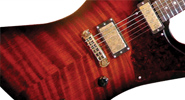
Echopark Ghetto Bird
Echopark Ghetto Bird
Price: $6,800 (as reviewed)
Contact: www.echoparkguitars.comYou know you’re holding something special when the guy who previously borrowed your review guitar was none other than Aerosmith guitarist Joe Perry, who apparently used this very Echopark Ghetto Bird – officially called Ancient Sinker Redwood Case Study #002 – for some recent recording work.
Echopark luthier Gabriel Currie makes high-end guitars that trade frills for exceptional materials and build quality. The Ghetto Bird, at its core, is a simple rock-and-roll machine with a body design that sits somewhere between a Gibson Firebird and a late-’70s RD Artist. The guitar has a custom three-toned Dusk Burst finish in nitrocellulose lacquer.
Our test Bird had an amazing figured/bookmatched redwood top that was carved from wood from ancient trees harvested from the bottom of Mendocino Lake, and a one-piece mahogany body with “tuned” chambering. For the neck, Currie used a 200-year-old piece of reclaimed Honduran mahogany. The fingerboard is old-stock Brazilian rosewood, while the headstock plate is bookmatched redwood and the nut is cut-and-polished bison bone. The pickguard is nitrate tortoiseshell.
The Ghetto Bird has a 245/8″ neck scale and a 12″ fingerboard radius with 22 frets of Jescar 55090 fretwire. One particularly cool feature is the pre-war-style open-gear tuners with an engraved nickel finish. Not only do they look classy, but they hold the tuning rock solid. The wraparound tailpiece is a TonePros AVT2 in hand-aged nickel with long steel bushings, and the control knobs are NOS Daka-Ware. Electronics include 500k CTS custom-taper pots, a Switchcraft three-position toggle, and an Asteron 047 vintage “paper in oil” tone cap. Even the strap buttons grab attention – in this case, 1959-style buttons in aged nickel. Finally, the Ghetto Bird’s PAF-style and Firebird-style mini-humbucker pickups are from Echopark’s Rose Series, custom-wound and etched by Rob Timmons.
In the hand, this Ghetto Bird is nicely balanced with a light, comfortable body (thanks to the weight-relieving chambers). The guitar has a big ol’ neck – like a ’50s Les Paul Junior – but is easy to grab and dig into.
Plugged in, the Ghetto Bird screams for rock and roll. Even without the Joe Perry connection, the guitar loves all sorts of bluesy, gnarly riffs and ’70s-style string bends. The redwood top imbues the mahogany with a little Fender quack, but thanks to the humbucker and the mini, there’s no 60-cycle hum – just a nice bit of twang on top of the ’bucker bang. From clean to slighty gritty to over-the-top crunch, the guitar is a blast to play, really loving the dirty tones, in particular. One would be hard-pressed to find a rock player who would not love this guitar’s feel and tone.
Granted, the Ghetto Bird comes at a premium price, but the materials are top-notch and every detail is meticulous. Its etched pickup covers are particularly sexy and the combination of a full-sized humbucker with a mini-humbucker is noteworthy. It’s a great rock-and-roll pairing, especially in conjunction with the properties of the mahogany and the redwood. The resulting tones bring to mind Leslie West, Rick Derringer, Mick Ronson, Perry and Brad Whitford, Steve Hunter and Dick Wagner, and other heroes of the classic-rock epoch. A big thumb’s up to Gabriel Currie for capturing the spirit of rock and roll, and for adding cool vintage touches like a wraparound bridge and open-gear tuners to seal the deal. This is some fine guitar building.
This article originally appeared in VG October 2013 issue. All copyrights are by the author and Vintage Guitar magazine. Unauthorized replication or use is strictly prohibited.
-
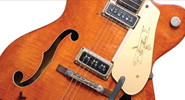
Earliest Gretsch 6120

Possessing pot codes dated April of 1954, serial number 13767 is the earliest documented Gretsch 6120. The pickguard is an accurate reproduction of the original.
6120 SN13767: Curt Wilson. Guitar courtesy of Fred Stucky.The Gretsch company rose to the upper echelon of guitar manufacturers in the 1950s with the introduction of a diverse and dynamic array of electric models. Arguably the most identifiable guitar design of that time was the Chet Atkins Hollowbody model 6120, with its distinctive orange-stained finish, “G-brand” body, and decidedly Western aesthetic. Recently, a previously undocumented prototype of this iconic model was uncovered, fueling renewed speculation and necessitating a fresh look at the genesis of the model.
Most Gretsch enthusiasts know the legend associated with the development of the 6120. It’s well documented that Atkins was recruited to endorse a signature model in hopes of duplicating the success Gibson enjoyed with its Les Paul model of the early ’50s. Hardcore fans of the 6120 might even be aware that its prototype, labeled as a Streamliner Special with serial number 13753, was presented to Atkins in early 1954. The story goes that Atkins made some suggestions and a second prototype (serial number 13770) was created reflecting his desire for the incorporation of a vibrato tailpiece and a metal nut. For this reason, this second prototypical guitar has generally been considered the first “6120 model.” The two share the distinctive unbound headstock – a characteristic not carried over to the three subsequent production batches of the model’s 1955 debut.
A relevant side-note is that Gretsch’s factory, located in Brooklyn, typically applied consecutively serial-numbered labels into groups of like-model guitars, creating sequentially numbered batches of 50 or 100 of each model. Serial numbers were printed on rolls of 50 labels, while model numbers were applied by rubber stamp as each label was applied to a finished guitar. For example, the initial production batch of the 6120 model was a 100-unit group documented from serial number 16450 to 16549. So, for the past five decades, it has been assumed that 48 of the labels that comprised the roll containing serial numbers 13750 through 13799 went curiously unused, with only numbers 13753 and 13770 being applied to the pair of 6120 prototypes created for Atkins.
That all changed recently, when 6120 collector Fred Stucky revealed the existence of a special specimen. Once owned by Bobby Cochran, nephew of the ’50s rocker/6120-playing icon Eddie Cochran, the guitar possesses the telltale unbound headstock feature common to the other two prototypes, and its label is stamped as a 6120 and carries the serial number 13767, certifying its origin to the development of the 6120.
The provenance of this guitar extends to 1962, when it was presented to Bobby when he was 12 years old. The story behind the acquisition offers frustratingly little insight into its origins and early life. It was purchased by Bobby’s father from an insurance salesman named Burke, who had called upon the Cochran residence. After realizing the family’s connection to Eddie Cochran, he informed them about his Gretsch, which was “…just like Eddie’s.”
Outside of the Cochran connection, which appears to be as utterly coincidental as it is ironic, the revelation that another 6120 specimen exists from the mysterious 137xx serial-numbered prototype batch, and in fact falls between the initial Streamliner Special (13753) and Chet Atkins’ first 6120 (13770) is thought-provoking to say the least!
The guitar is gorgeous, with a nicely flamed maple top, deep ruddy-orange finish, and gold-plated hardware with just the right amount of patina. Equipped with the DeArmond Dynasonic single-coil pickups Gretsch was using exclusively at the time, the guitar plays amazingly well. Despite its historical significance and the fact some feel it should be in a museum, Stucky has recorded with it and is prone to periodically play it at gigs with his band, Gas Money.
Though the guitar embodies all of the cowboy motifs the 6120 has come to be known for, several of its features depart from the subsequent debut format of the ’55 Chet Atkins 6120. Most conspicuous is the anodized fixed-arm Bigsby vibrato tailpiece – a B6 on the ’55, but, inexplicably, a smaller B3 on the 13767 guitar. Equally unusual is the headstock ornamentation incorporating a white diamond on the face, just under the inlaid steer’s head. The original pickguard, disintegrated, but perhaps the first “signpost”-style example ever produced, also possesses a white strip of plastic, matching the material used to make the diamond on the headstock (shown in the photo of Bobby Cochran).

(LEFT) A young Bobby Cochran with his Gretsch 6120 (serial number 13767) – just like his Uncle Eddie’s. (RIGHT) Chet Atkins with his Gretsch “Streamliner Special” prototype (serial number 13753), already experimenting with a vibrato tailpiece at the Grand ‘Ol Opry in August of 1954.
Bobby Cochran photo courtesy of Bobby Cochran. Chet Atkins with Streamliner Specail: Gordon Gillingham/courtesy of the Grand Ole Opry Archives.One feature each of the three extant prototypes do share with the first production batch of 6120 guitars is their 21-fret fingerboard, no doubt an attribute carried over from the influential Streamliner spec. The fretboard was quickly updated to 22 frets in the second batch of 1955, retaining that characteristic throughout the 17-year lifespan of the model.
Other idiosyncrasies of the 13767 guitar include a seam of white binding at the tail, visible below the Bigsby bracket and strap button. The neck heel appears to be quite narrow when compared to ’55 examples. The pickguard has a small brass support extension protruding from the side of the fretboard, which is atypical for the 6120. Finally, the inlaid steers-head, sound-hole outline, and cutaway angle all appear to be slightly different from what resulted on later production examples. These anomalies, along with an impressive build quality, suggests that this guitar, presumably constructed for Atkins’ evaluation and use, was hand-made from the ground up.
Probably the most significant feature is the “6120” model stamp on its interior label. Based on the sequential nature of the serializing process at the factory, that makes this guitar – not Atkins’ own, number 13770 – the earliest 6120 ever documented. Technically, this also makes these two 6120-stamped instruments the only 1954 Atkins 6120 models known to exist.

Interior label: Curt Wilson. The discovery of number 13767 will fuel debate and speculation as to the existence of others, and those 47 labels numbered 137xx are still unaccounted for. In reality, the emergence of this guitar creates more questions than it answers, but for now, 13767 is the first Gretsch-made guitar to receive a Bigsby and metallic gold “signpost” pickguard, since the Streamliner Special prototype originally possessed a brown tortoise pickguard and static (Roundup-style) tailpiece.
The survival of 13767 leads to speculation that with Atkins’ feedback to Gretsch on the original Streamliner Special, perhaps several prototypical 6120 examples, each with slightly varying features, were assembled. It’s unclear why Atkins favored 13770, or where the others (if there were others) might have ended up. Further, mystery persists around how this previously undocumented example managed to escape into the world and find its way into the family of one of the model’s most notable devotees. What is clear, however, is the undisputable impact that the 6120, enabled by the creation of these three 137xx batch prototypes, has had on the Gretsch company and brand. Today, almost 60 years later, more than 20 reissue and 6120-inspired models are being marketed, a testimony to the iconic status that the Chet Atkins 6120 model has ascended to.
Ed Ball is the author of Gretsch 6120, The History of a Legendary Guitar (Schiffer Publishing, 2010)
This article originally appeared in VG October 2013 issue. All copyrights are by the author and Vintage Guitar magazine. Unauthorized replication or use is strictly prohibited.


